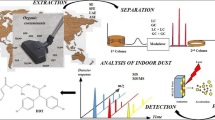Abstract
The Reiss-Engelhorn-Museen in Mannheim, Germany requested support from a toxicological laboratory in evaluating occupational exposures before a cleanup and renovation period in 2006. Samples of dust and dirt and scrapings of exhibits were collected from several locations. Following toxicologically relevant compounds could be identified by gas chromatography – mass spectrometry (GC/MS) by comparison with a mass spectra library: dichlorodiphenyl trichloroethane (DDT) and its breakdown product dichlorodiphenyl dichloroethane (DDD) as well as dichlorodiphenyl dichlorethylene (DDE), methoxychlor, nicotine, and camphor. In recent times various insecticides have been used to protect museum artefacts against moths, woodborers and other insect pests. Caution has to be made because the presence of hazardous compounds can result in security problems for museum staff as well as for visitors.

Similar content being viewed by others
References
Centers for Disease Control, Prevention (1983) DDT exposure in a Natural History Museum—Colorado. MMWR 32:443–444
Dawson J, Strang TJK (1992) Solving museum insect problems: chemical control. Canadian Conservation Institute, Ottawa
Glastrup J (1986) Insecticide analysis by gas chromatography in the stores of the danish national museum’s ethnographic collection. Stud Conservat 32:59–64
Goldberg L (1996) A history of pest control measures in the anthropology collections, national museum of natural history, smithsonian institution. JAIC 35:23–43
Hawks C (2001) Historical survey of the sources of contamination of ethnographic materials in museum collections. Collect Forum 16:2–11
Merkord J (1994) Gefahren im Umgang mit Fungiziden & Bioziden. Restauro 3:170–173
Muir D (1981) Health hazards in natural history museum work. Museums Journal 80:205–206
Palmer PT (2001) A review of analytical methods for the determination of mercury, arsenic, and pesticide residues on museum objects. Collect Forum 16:25–41
Palmer PT, Martin M, Wentworth G, Caldararo N, Davis L, Kane S, Hostler D (2003) Analysis of pesticide residues on museum objects repatriated to the Hupa tribe of California. Environ Sci Technol 37:1083–1088
Pfleger K, Maurer HH, Weber A (2000) Mass spectral and GC data of drugs, poisons, pesticides and their metabolites, 2nd edn. Wiley-VCH, Weinheim, Germany
Purewal V (2001) The identification of four persistent and hazardous residues present on historic plant collections housed within the national museum and galleries of wales. Collect Forum 16:77–86
Sirois PJ (2001) The analysis of museum objects for the presence of arsenic and mercury: non-destructive analysis and sample analysis. Collect Forum 16:65–75
Author information
Authors and Affiliations
Corresponding author
Rights and permissions
About this article
Cite this article
Musshoff, F., Gottsmann, S., Mitschke, S. et al. Potential Occupational Exposures in the Reiss-Engelhorn-Museen Mannheim/Germany. Bull Environ Contam Toxicol 85, 638–641 (2010). https://doi.org/10.1007/s00128-010-0113-y
Received:
Accepted:
Published:
Issue Date:
DOI: https://doi.org/10.1007/s00128-010-0113-y




